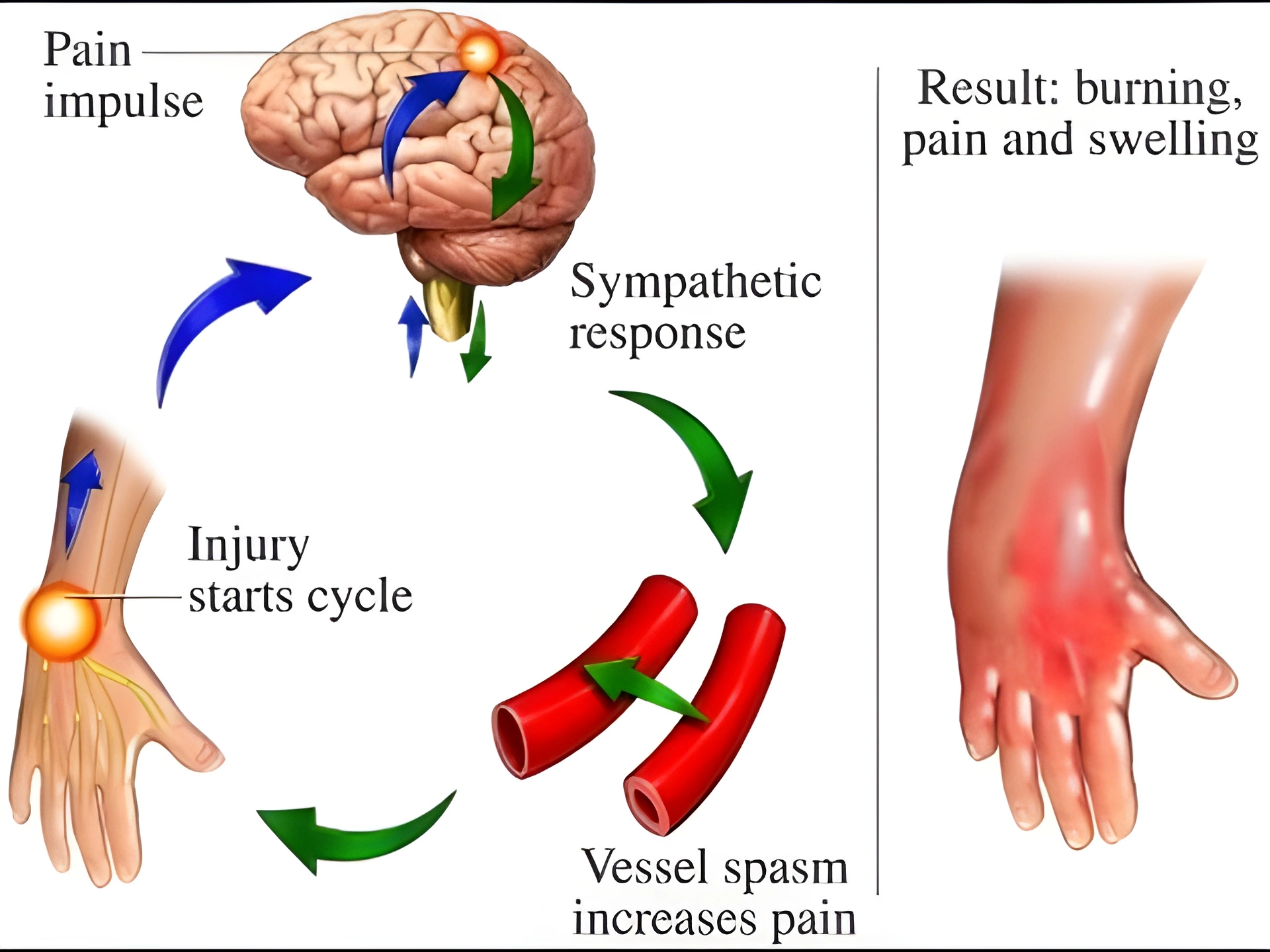In the 19th century, Silas Weir Mitchell first described Complex Regional Pain Syndrome (CRPS) as the amalgamation of pain. Over time, the symptoms were not limited to just simply an area of pain, but spread to involve muscle, bone, joint, skin and blood vessels; eventually spreading to the spinal cord and causing changes in the brain.
This syndrome usually starts after a trauma leading to changes in the skin, causing severe pain and swelling in the affected area, limiting movement. If CRPS is not treated early, it can progress quickly, becoming a chronic syndrome with severe permanent disability.
What Is A Complex Regional Pain Syndrome?
Pain that persists after an injury has healed is referred to as a chronic pain syndrome. Complex Regional Pain Syndrome is a type of chronic pain where the nerves themselves have developed an injury, creating a short circuit in the nervous system and causing a feedback loop of pain and disability. It usually occurs in the legs or arms. It is caused by a previous injury, which often doesn’t seem terribly severe.
Dysfunction of injured peripheral sensory neurons causes the majority of CRPS, which has subsequent consequences on the spinal cord and brain. CRPS can also be caused by other major or minor traumas, such as surgery, heart attacks, infections, and even sprained ankles. Splintered bones or a tight cast might generate nerve damage or displacement. It’s unclear why all these types of injuries can provoke CRPS.
Understanding The Types Of CRPS:
CRPS is of two types:
Types 1 and 2 were initially called Reflex Sympathetic Dystrophy and Causalgia. The distinction between these two forms is whether or not there is nerve injury.
Type 1 causes no nerve damage. However, type 2 causes nerve impairment. As per the National Institute of Neurological Disorders and Stroke, approximately 90% of persons with CRPS have type 1. Although CRPS is more common in women, it can affect anyone including children.
Symptoms of Complex Regional Pain Syndrome:
- Constant or fluctuating pain during movement.
- Changes in the affected limb’s skin temperature, texture, color, or inflammation.
- Excessive or persistent pain upon use or contact.
- Sweating abnormally, as well as nail and hair growth.
- Rigid joints
- Excessive bone growth
- Hampered muscle strength
Stages Of Complex Regional Pain Syndrome
It mainly occurs in three stages: Acute, Dystrophic, and Atrophic.
Stage 1- Acute:
In the initial phase, one might experience the following symptoms–
- Burning or pain due to pressurized appendage
- Pain spreads in the entire arm or leg
- Skin temperature changes in the affected area
- Color of the affected limb changes to red, gray-blue, or purple, indicating improper blood circulation
- Impaired muscle movement
- Poor circulation of blood leads to limited action lowering muscle strength
Stage one affects your limbs that lasts for about one to three months.
Stage 2-Dystrophic:
The second stage, often known as the subacute period, lasts three to nine months and is characterized by worsening symptoms. Your skin may continue to alter throughout this time, and your nails may become fragile and easily cracked. The pain in the joints becomes much more intense, causing them to stiffen, and hence resulting in muscles to weaken. You will probably also have acute and continual burning pain and problems with motility in the areas where you are suffering. During this time, hair growth also tends to slow down.
Stage 3-Atrophic:
Since this stage comes around a year after the first onset, you are likely to be in continual anguish if you enter this phase, also known as the chronic stage. This stage can extend for months, years, or perhaps your entire life. The degree of the pain may be periodic or constant. Still, you are frequently limited in accomplishing ordinary daily duties. Atrophy can develop in some circumstances, leading to the loss of limb function. Frozen shoulders or claw hands are possible extreme cases.
Diagnosis And Treatment
While there are no known causes for CRPS, if you are suffering from persistent pain or any other similar symptoms, you should consult a doctor;
- Detailed examination by a doctor acquainted with typical patterns of sensory nerve anatomy, such as a neurologist, orthopedist, or plastic surgeon. When patients are asked to outline their most abnormal skin, the damaged nerve is frequently revealed.
- Nerve conduction investigations can detect some CRPS-related nerve damage.
- To image nerves, ultrasound or magnetic resonance imaging (MRI), also known as magnetic resonance neurography (MRN), can sometimes show underlying nerve damage. On MRI, specific bone and bone marrow anomalies can aid in identifying the damaged nerve.
- Excess bone resorption associated with CRPS can sometimes be seen on triple-phase bone scans (using a dye), which can aid in diagnosis and localization.
However, these tests might confirm CRPS but are not absolutely definitive. They will assist in determining therapy choices.
CRPS Treatment Options
- Consider having stimulating electrodes inserted into the spine via the spinal cord with the help of a needle. This aids in blocking pain felt and normalization of the brain-spinal cord connection.
- Medication: To assist you in dealing with symptoms, your doctor may prescribe various drugs. You may be prescribed blood pressure drugs, antidepressants, and pain relievers to aid inflammation.
- Surgery: Surgery includes severing the nerves and blocking pain signals from reaching the brain. It is considered a last resort.
- Desensitization therapy is the essential treatment for CRPS. It keeps the limbs moving, improves blood circulation, maintains flexibility, and prevents muscle and tissue loss.
- Psychotherapy: If you are sad, nervous, or suffering from post-traumatic stress disorder, you should get help from a psychologist.
The Bottom Line
It is crucial to diagnose and treat complex regional pain or regional sympathetic neuropathy syndrome early, if you want the best results. CRPS or RSD should be treated as soon as it is discovered or even considered as a possible diagnosis. The Padda Institute – Center For Interventional Pain Management offers long-term pain reduction strategies. We are considered one of St. Louis’ best pain treatment specialists and are known to have helped many suffering from chronic pain related disorders. Get help today!




